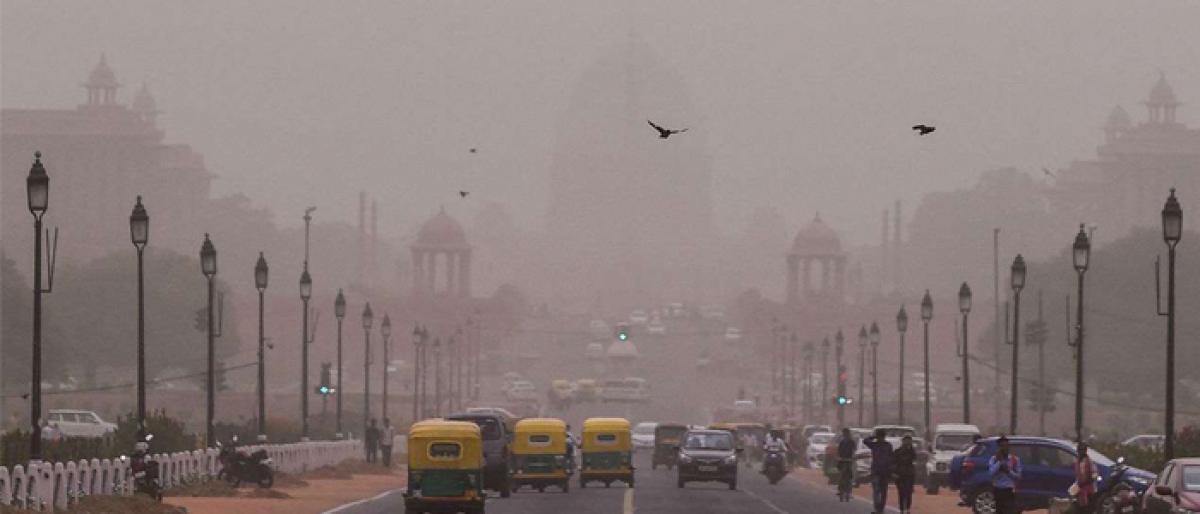Live
- Sandhya Theater Stampede Incident: Rahul Ramakrishna Retracts Comments on Issue
- Garena Free Fire MAX Redeem Codes for December 2024: Unlock Skins, Weapons, and More
- Dr. Ponguleti Sudhakar Reddy Welcomes Union Minister Piyush Goyal in Bengaluru
- Why Christmas is Celebrated on December 25: The Link to Roman Festivals
- Tributes paid to G Venkataswamy (Kaka)
- Amit Shah should quit; demand MP, MLA
- Hike in support price brings cheer to coconut farmers
- Apple's Face ID Smart Doorbell Could Unlock Doors by Late 2025
- Amit Shah must tender apology
- Govt’s focus on rural and tribal health: Minister Damodar
Just In
Air quality remains ‘severe’ : Hussain discusses worsening air quality with officials


Environment Minister Imran Hussain met his ministry officials on Friday to discuss the deteriorating air quality in the national capital which slipped to severe plus emergency category after Diwali
New Delhi: Environment Minister Imran Hussain met his ministry officials on Friday to discuss the deteriorating air quality in the national capital which slipped to "severe plus emergency" category after Diwali.
A thick haze engulfed Delhi on Thursday as it recorded its worst air quality of the year the morning after Diwali, with the pollution level entering "severe-plus emergency" category or 10 times the permissible limit due to rampant bursting of toxic firecrackers in gross violation of a Supreme Court order, authorities said.
Hussain met officials of the Environment Ministry to discuss the deteriorating air quality and plan action if the air quality remains hazardous, officials said.
The Supreme Court-appointed Environment Pollution (Prevention and Control) Authority on Thursday said it was closely monitoring the situation and if the pollution shows an increasing trend then emergency measures will be imposed in the national capital.
The emergency measures would be implemented as prescribed under the Graded Response Action Plan (GRAP). Under the GRAP, stringent actions are implemented based on the air quality of the city.
‘Toxic’ situation may aggravate
Delhi's pollution level remained in the 'severe' category for the second day, even as authorities warned that the already toxic situation caused by smoke from fireworks is likely to aggravate further due to intensified stubble burning in neighbouring states.
The overall air quality index (AQI) was recorded at 421 which falls in the 'severe' category, according to data from the Central Pollution Control Board (CPCB).
The Centre-run System of Air Quality and Weather Forecasting and Research (SAFAR) recorded the AQI at 453. Faridabad, Ghaziabad, Noida and Greater Noida recorded air quality in the "severe" category, while Gurgaon registered "very poor" air quality.
In NCR districts, the highest AQI was recorded in Faridabad at 460. SAFAR said the city's air quality has "improved significantly" since Thursday but warned that the already toxic situation caused by smoke from fireworks is likely to aggravate further due to intensified stubble burning in neighbouring states.
"As per satellite images, heavy fire counts were recorded in the last 24 hour and the latest SAFAR model results show a movement of cold front carrying heavy air mass towards Delhi region," SAFAR said.
Further, the air in the surrounding stubble-burning areas is already heavy due to increased moisture and pollutants. This heavy air will travel towards Delhi, where a similar situation exists, in the next 24 hours.
This combined effect might add to the pollution woes. "There is a possibility that the wind may pick up at the upper level, late in the night and push the level of pollution and keep it in ‘severe’ zone on Saturday with intensified fog, which will further trap the pollutants," it said.
Twenty-six areas in Delhi recorded 'severe' air quality, while seven areas recorded 'very poor' air quality, according to the data of the CPCB. On Friday, the PM2.5 (particles in the air with a diameter of less than 2.5 micrometres) level was recorded at 303 µg/m3, six times the permissible limit.
The PM10 (particles in the air with a diameter of less than 10 micrometres) level was recorded four times the permissible limit at 440 µg/m3, according to SAFAR. India's official permissible PM2.5 limit is 60 µg/m3, while that of PM10 level is 100 µg/m3.
A 'severe' air quality index (AQI) essentially means that even healthy people may suffer from respiratory illnesses on a prolonged exposure to such air. This air will seriously affect those with ailments, according to the advisory issued by SAFAR.
AQI above 500 falls in the "severe-plus emergency" category. AQI is the combined impact of different pollutants, including PM (particulate matter) 10, PM 2.5, nitrogen and sulphur oxides, and ozone.
Delhi's air quality on Thursday went off the charts to the "severe plus emergency" category as smog caused due to smoke from firecrackers engulfed the national capital.
The overall AQI on Thursday was recorded in the "severe plus emergency" category at 642, according to data from SAFAR. The spike in pollution levels on Thursday led to the formation of a smoky layer across the national capital and drastically reduced visibility, authorities said.

© 2024 Hyderabad Media House Limited/The Hans India. All rights reserved. Powered by hocalwire.com






